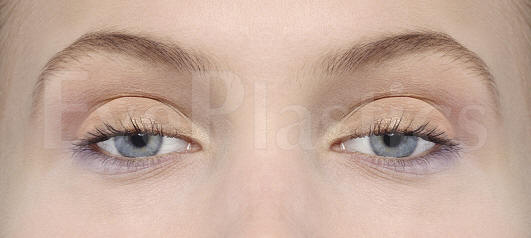Ptosis

- Ptosis is an abnormally low position (drooping) of the upper eyelid
- Ptosis occurs when the muscles that raise the eyelid (levator and Müller's muscles) are not strong enough to do so well.
- It can affect one eye or both eyes and occurs more often in the elderly, as muscles in the eyelids may possibly begin to deteriorate.
- Compare with dermatochalsis (extra skin and fat)
Defintion
- Ptosis is an abnormally low position (drooping) of the upper eyelid
- The drooping may possibly be worse after being awake longer, when the individual's muscles are tired.
- This condition is may be called "lazy eye", but that term normally refers to amblyopia.
- If severe enough and left untreated, the drooping eyelid can cause other conditions, such as amblyopia or astigmatism.
- This is why it is especially important for this disorder to be treated in children at a young age, before it can interfere with vision development.
NOTE
There are two 'main' surgeries that may possibly be performed on the upper eyelid.
This section addresses Ptosis which is the medical term for drooping of the
upper eyelid; it may possibly affect one or both eyes.
The other surgery of the upper eyelid addresses excess skin is repaired by blepharoplasty.
Ptosis occurs when the muscles that raise the eyelid (levator and Müller's muscles) are not strong enough to do so well. It can affect one eye or both eyes and occurs more often in the elderly, as muscles in the eyelids may possibly begin to deteriorate.
- Ptosis can be caused by the apneurosis of the levator muscle, nerve abnormalities, trauma, inflammation or lesions of the lid or orbit.
- Dysfunctions of the levators may possibly occur as a result of a lack of nerve communication being sent to the receptors due to antibodies needlessly attacking and eliminating the neurotransmitter.
- Ptosis may possibly be due to a myogenic, neurogenic, aponeurotic, mechanical or traumatic cause and it usually occurs isolated, but may possibly be associated with various other conditions, like immunological, degenerative, or hereditary disorders, tumors, or infections
- Acquired ptosis is most commonly caused by aponeurotic ptosis. This can occur as a result of senescence, dehiscence or disinsertion of the levator aponeurosis. Moreover, chronic inflammation or intraocular surgery can lead to the same effect. Also, wearing contact lenses for long periods of time is thought to have a certain impact on the development of this condition.
- Congenital neurogenic ptosis is believed to be caused by the Horner syndrome.
- In this case, a mild ptosis may possibly be associated with psilateral ptosis, iris and areola hypopigmentation and anhidrosis due to the paresis of the Mueller muscle. Acquired Horner syndrome may possibly result after trauma, neoplastic insult, or even vascular disease.
- Ptosis due to trauma can ensue after an eyelid laceration with transection of the upper eyelid elevators or disruption of the neural input.
- Other causes of ptosis include eyelid neoplasms, neurofibromas or the cicatrization after inflammation or surgery. Mild ptosis may possibly occur with aging.

.png)

.jpg)
.jpg)
.jpg)
.jpg)
.jpg)
.jpg)
.jpg)
.jpg)
.jpg)
.jpg)
.jpg)
